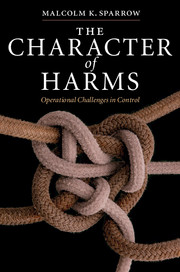Book contents
- Frontmatter
- Contents
- List of figures
- Acknowledgments
- Introduction
- Part I The nature of the control task
- 1 Which way up, and does it matter?
- 2 A different type of work
- 3 Defining problems: setting the scale
- 4 Defining problems: picking the dimensions
- 5 Patterns of thought and action
- 6 Puzzles of measurement
- 7 Structures, protocols, and interactions
- Part II Special categories of harms
- Conclusion
- Index
7 - Structures, protocols, and interactions
from Part I - The nature of the control task
Published online by Cambridge University Press: 06 July 2010
- Frontmatter
- Contents
- List of figures
- Acknowledgments
- Introduction
- Part I The nature of the control task
- 1 Which way up, and does it matter?
- 2 A different type of work
- 3 Defining problems: setting the scale
- 4 Defining problems: picking the dimensions
- 5 Patterns of thought and action
- 6 Puzzles of measurement
- 7 Structures, protocols, and interactions
- Part II Special categories of harms
- Conclusion
- Index
Summary
The idea of focusing on carefully identified concentrations of harm and unpicking them one by one sounds simple and straightforward enough: pick important problems, and fix them. The fact, however, that initiatives and organizational behaviors pointing in this direction are seen as departures from the norm and celebrated as innovations suggests there is something not entirely obvious about the practical implementation of this idea. The associated operational practices remain awkward, unfamiliar, and (for many institutions) elusive. If the relevant organizational behaviors were well established, and the mechanisms needed to support them well understood, then there would be nothing innovative about this type of conduct.
I find that practitioners often take offense, at first, when we discuss what it would mean for their organization to pick important problems, and fix them. “You are insulting us,” they say. “Everything we do is about that.” They assume their existing operations cover this, even though most of their work is still organized around functions and processes. Sometimes they can point to specific problems spotted and solved (like the US Customs Service, with their port-running problem), even though the patterns of thought and action they used in those cases have not been generalized nor institutionalized.
Information
- Type
- Chapter
- Information
- The Character of HarmsOperational Challenges in Control, pp. 149 - 168Publisher: Cambridge University PressPrint publication year: 2008
